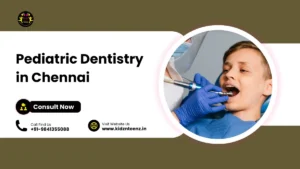It’s not every day a newborn surprises their parents with tiny teeth already poking through the gums. These are known as natal and neonatal teeth present at birth or erupting within the first month. While they may seem alarming, identifying them early ensures safe feeding and proper care through timely pediatric dental and medical evaluation.
What are Natal Teeth?
Natal teeth are teeth that are present in a baby’s mouth at birth. They usually appear in the lower front gum and are part of the normal set of primary teeth. These early teeth may be loose, underdeveloped, or have weak roots. Since natal and neonatal teeth in infant can cause feeding difficulties or mouth irritation, a pediatric dentist should evaluate them to decide if treatment or removal is needed for the baby’s comfort and safety.
Symptoms of Natal and Neonatal Teeth
Natal and neonatal teeth are usually noticed at or shortly after birth. While some babies may not show any discomfort, others
- Early Tooth Eruption: Natal teeth are present at birth; neonatal teeth emerge within the first 30 days. Both may be fully or partially erupted.
- Feeding Discomfort: These teeth can cause soreness during nursing, affect latching, and irritate the baby’s tongue or gums, leading to feeding difficulties.
- Tongue Injury (Riga-Fede Disease): Loose or sharp teeth may cause tongue ulcers, impacting comfort and feeding.
- Poor Weight Gain: Painful feeding can reduce milk intake, leading to inadequate weight gain.
- Loose Teeth Risk: Poorly rooted teeth may pose a choking hazard and require dental evaluation.
- Mother’s Discomfort: Sharp teeth can cause nipple pain or injury, affecting breastfeeding continuity.
Early detection helps manage symptoms and ensure the well-being of both mother and baby.
Causes of Natal and Neonatal Teeth in Infant
While the exact cause of natal and neonatal teeth in infant is not always clear, several factors are believed to contribute to their early eruption. These teeth are often part of the normal set of natal teeth syndrome, just appearing earlier than usual. Below are key causes and contributing conditions:
- Hereditary Factors: A family history of early tooth eruption is one of the most common causes. If a parent or close relative had natal or neonatal teeth, the infant may also develop them due to genetic predisposition.
- Developmental Disturbances: Certain disturbances in tooth development during pregnancy may lead to early eruption. These may be linked to localized hormonal imbalances or changes in the growth patterns of the gums and jaw.
- Syndromic Associations: Some congenital syndromes such as Ellis-van Creveld syndrome, Sotos syndrome, or Hallermann-Streiff syndrome, are associated with natal and neonatal teeth in infant. In such cases, early tooth eruption may occur alongside other developmental anomalies.
- Nutritional and Hormonal Influences: Unusual levels of maternal hormones or nutrients during pregnancy could play a role in triggering premature tooth development. However, more research is needed to confirm a direct correlation.
- Superficial Position of Tooth Germs: In some infants, the tooth buds (germs) are located closer to the surface of the gum. This positioning can lead to the early emergence of teeth, Are natal teeth primary teeth often before the gums are fully developed to support them.
These causes highlight the need for professional evaluation to determine whether the early eruption is a harmless variation or a sign of an underlying condition.
Are There Different Types of Natal Teeth?
Yes, natal teeth can be categorized into types based on their appearance, structure, and degree of development. Understanding these variations helps in assessing their stability and potential risks. Knowing the difference between natal and neonatal teeth is also crucial for diagnosis and care.
- Fully Developed Natal Teeth: These teeth resemble normal primary teeth in size and shape. They are usually well-formed and may be located in the lower front gum area, but their root structure is often underdeveloped, making them mobile.
- Partially Developed or Shell-Shaped Teeth: Some natal teeth appear as shell-like structures with no solid root. Are natal teeth primary teeth are fragile, loosely attached to the gums, and are more prone to breaking or falling out, increasing the risk of aspiration.
- Teeth with Poor Root Formation: In many cases, natal teeth erupt prematurely without proper root anchorage. This makes them highly mobile and often requires monitoring or removal, especially if feeding is impacted or there’s risk of choking.
- Teeth Associated with Oral Anomalies: Rarely, natal teeth may be associated with syndromes or craniofacial abnormalities such as Ellis-van Creveld or Pierre Robin sequence. These orthodontic services might appear irregular in shape or number and need a comprehensive evaluation.
Understanding the difference between natal and neonatal teeth is key: natal teeth are present at birth, while neonatal teeth erupt within the first 30 days. Both types may fall into these structural categories, and their management depends on form, function, and risks involved.
What Are Possible Complications of Natal Teeth?
Although natal and neonatal teeth may seem harmless, they can lead to various complications affecting feeding, comfort, and overall health. Identifying these issues early helps guide appropriate treatment and prevent long-term problems.
- Feeding Difficulties: Natal teeth may interfere with breastfeeding by affecting the baby’s latch or causing pain for the mother. Improper latching can lead to inadequate milk intake, slow weight gain, or refusal to feed.
- Risk of Aspiration: If the tooth is poorly rooted or extremely loose, it poses a choking hazard. Accidental dislodgement during feeding or crying can lead to the tooth being inhaled into the airway.
- Ulcers on the Tongue (Riga-Fede Disease): Sharp edges of natal teeth can irritate the underside of the tongue, causing painful ulcers. This frenectomy in infants condition may discourage the baby from feeding or lead to excessive crying.
- Gagging or Swallowing Issues: The presence of an unexpected tooth may confuse the infant’s swallowing reflex. This can lead to coughing, choking, or poor coordination while feeding.
- Misalignment of Future Teeth: Early eruption may disrupt the alignment of permanent teeth later in life. In some cases, Natal teeth syndrome can affect the proper development of primary tooth buds.
- Increased Risk of Infection: Since the oral tissues are still developing, any injury caused by sharp natal teeth may create an entry point for bacteria. This increases the risk of oral infection or inflammation.
Monitoring natal and neonatal teeth in infant and addressing these complications through dental care and pediatric follow-up ensures the baby remains comfortable, safe, and able to feed effectively.
How are Natal Teeth Treated?
Natal teeth are present at birth, whereas neonatal teeth erupt within the first 30 days after birth. Both types can present challenges for feeding, oral development, and maternal comfort during breastfeeding. Proper evaluation and timely intervention are essential to ensure the infant’s safety and wellbeing.
- Initial Assessment and Diagnosis: Neonatal teeth treatment begins with a thorough clinical examination by a pediatric dentist or pediatrician to determine the tooth’s mobility, structure, and impact on feeding. Radiographic evaluation may be used to confirm whether the tooth is a primary tooth erupting prematurely or a supernumerary (extra) tooth problems latching on newborn.
- Monitoring Stable Teeth: If the Natal teeth syndrome is firm, not interfering with feeding, and does not pose a risk of aspiration, it is often left in place under careful observation. Parents are advised to maintain oral hygiene and monitor for any signs of irritation or ulceration.
- Extraction of Highly Mobile Teeth: Teeth that are extremely loose or poorly rooted are often extracted to prevent the risk of accidental inhalation or swallowing. The Neonatal teeth treatment extraction procedure is generally simple and may not require anesthesia, but vitamin K status must be evaluated to avoid bleeding complications.
- Managing Feeding Complications: If the are natal teeth primary teeth of natal or neonatal teeth causes discomfort to the breastfeeding mother or trauma to the infant’s tongue (such as Riga-Fede disease),Neonatal teeth treatment may involve smoothing the tooth edges or applying protective dental materials. In more severe cases, tooth extraction might be required to enable comfortable and pain-free feeding.
Please confirm if you’d like the next subsection on “Difference between natal and neonatal teeth” or a continuation with more treatment details.
Can Natal Teeth be Prevented?
natal and neonatal teeth in infant are uncommon in infants and are typically influenced by genetic and developmental factors. While their exact cause is not fully understood, current medical knowledge suggests that true preventive care may not always be possible.
- Genetic Factors and Family History: A family history of natal or neonatal teeth has been observed in some cases, indicating a possible hereditary component. Genetic predisposition means that prevention may be limited, though awareness of family patterns can help in early monitoring.
- Maternal Health and Environmental Influences: Certain maternal conditions, such as fever during pregnancy or nutritional deficiencies, have been loosely associated with early tooth eruption. Although evidence is inconclusive, maintaining good prenatal health and balanced nutrition may support normal fetal development.
- Lack of Proven Preventive Measures: There are no medically established interventions to prevent natal or neonatal teeth, Restorative dentistry as their emergence is not typically linked to controllable external factors. Focus is therefore placed on early detection and appropriate treatment rather than prevention.
Conclusion
Natal and neonatal teeth can be either harmless or cause complications depending on their stability and impact on feeding. Early evaluation and proper care are essential to ensure safety, comfort, and healthy oral development. Monitoring these teeth helps address any issues promptly for the well-being of the infant.
Read also: Problems latching on Newborn




